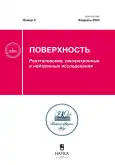Simulation of the Diffusion of Copper Atom on Graphene by Molecular Dynamics
- Авторлар: Khudyakov S.V.1, Kolesnikov S.V.1, Saletsky A.M.1
-
Мекемелер:
- Lomonosov Moscow State University
- Шығарылым: № 2 (2024)
- Беттер: 48-53
- Бөлім: Articles
- URL: https://journals.rcsi.science/1028-0960/article/view/257502
- DOI: https://doi.org/10.31857/S1028096024020077
- EDN: https://elibrary.ru/BAPGSL
- ID: 257502
Дәйексөз келтіру
Толық мәтін
Аннотация
The results of studying the effect of geometric and thermodynamic parameters of thermal evaporation and copper deposition on graphene lying on the Cu(111) surface on the adsorption of copper atoms, as well as their surface diffusion, are presented. The simulation was carried out by classical molecular dynamics using chains of Nose–Hoover thermostats. Interatomic interactions were determined by the Tersoff–Brenner, Rosato–Gillop–Legrand, and modified Morse potentials. A simple criterion for the thermalization of adatoms on graphene lying on a Cu(111) surface was formulated and tested. The average length and mean time of free path of a copper atom before and after thermalization at low (7 K) and room temperatures were studied for two evaporation temperatures. The probability of adsorption of a copper atom was found. The distributions along the directions of motion of adatoms during equilibrium diffusion were constructed. The distributions of the free path length and time were shown to have an exponential form. The influence of the Cu(111) substrate on the diffusion of the Cu atom on graphene was studied. The results obtained can be used to simulate the growth of copper nanoclusters on graphene by the kinetic Monte Carlo method.
Авторлар туралы
S. Khudyakov
Lomonosov Moscow State University
Хат алмасуға жауапты Автор.
Email: serhmsu@gmail.com
Ресей, Moscow
S. Kolesnikov
Lomonosov Moscow State University
Email: serhmsu@gmail.com
Ресей, Moscow
A. Saletsky
Lomonosov Moscow State University
Email: serhmsu@gmail.com
Ресей, Moscow
Әдебиет тізімі
- Wallace P.R. // Phys. Rev. 1947. V. 71. № 9. P. 622. http://doi.org/10.1103/physrev.71.622
- Novoselov K.S., Geim А.К., Morozov S.V., Jiang D., Zhang Y., Dubonos S.V., Grigorieva I.V., Firsov A.A. // Science. 2004. V. 306. P. 666. http://doi.org/10.1126/science.1102896
- Novoselov K.S., Geim A.K., Morozov S.V., Jiang D., Katsnelson M,I., Grigorieva I.V., Dubonos S.V., Fir- sov A.A. // Nature. 2005. V. 438. P. 197. http://doi.org/10.1038/nature04233
- Castro Neto A.H., Guinea F., Peres N.M.R., Novoselov K.S., Geim A.K. // Rev. Mod. Phys. 2009. V. 81. P. 109. http://doi.org/10.1016/j.physrep.2010.07.003
- Vozmediano M.A.H., Katsnelson M.I., Guinea F. // Phys. Rep. 2010. V. 496. № 4–5. P. 109. http://doi.org/10.1016/j.physrep.2010.07.003
- Nakhmedov E, Nadimi E., Vedaei S., Alekperov O., Tatardar F., Najafov A.I., Abbasov I.I., Saletsky A.M. // Phys. Rev. B. 2019. V. 99. P. 125125. http://doi.org/10.1103/PhysRevB.99.125125
- Zheng Zh., Ma Qi., Bi Zh., Barrera S., Liu M.-H., Mao N., Zhang Ya., Kiper N., Watanabe K., Taniguchi T., Kong J., Tisdale W.A., Ashoori R., Gedik N., Fu L.,. Xu S.-Ya, Jarillo-Herrero P. // Nature. 2020. V. 588. P. 71. http://doi.org/10.1038/s41586-020-2970-9
- Zhou H., Yu W.J., Liu L., Cheng R., Chen Y., Huang X., Liu Y, Wang Y, Huang Y., Duan X. // Nature Commun. 2013. V 4. P. 2096. http://doi.org/10.1038/ncomms3096
- Giovannetti G., Khomyakov P.A., Brocks G., Karpan V.M., Brink J., Kelly P.J. // Phys. Rev. Lett. 2008. V. 101. P. 026803. http://doi.org/10.1103/PhysRevLett.101.026803
- Lu Z., Wang Ya. Chen J., Wang J., Zhou Ye, Han S.-T. // Chem. Rev. 2020. V. 120. P. 3941. http://doi.org/10.1021/acs.chemrev.9b00730
- Karpan V.M., Giovannetti G., Khomyakov P.A., Talana-na M., Starikov A.A., Zwierzycki M., Brink J., Brocks G., Kelly P.J. // Phys. Rev. Lett. 2007. V. 99. P. 176602. http://doi.org/10.1103/PhysRevLett.99.176602
- Sule P., Szendro M., Hwang C., Tapaszto L. // Carbon. 2010. V. 77. P. 1082. http://doi.org/10.1016/j.carbon.2014.06.024
- Shi X., Yin Q., Wei Y. // Carbon. 2012. V. 50. P. 3055. http://doi.org/10.1016/j.carbon.2012.02.092
- Liu X., Han Y., Evans J.W., Engstfeld A.K., Behm R.J., Tringides M.C., Hupalo M., Lin H.-Q., Huang L., Ho K.-M., Appy D., Thiel P.A., Wang C.-Z. // Progress Surf. Sci. 2015. V. 90. P. 397. http://doi.org/10.1016/j.progsurf.2015.07.001
- Soy E., Liang Z., Trenary M. // J. Phys. Chem. C. 2015. V. 119. № 44. P. 24796. http://doi.org/10.1021/acs.jpcc.5b06472
- Soy E., Guisinger N., Trenary M. // J. Phys. Chem. B. 2018. V. 122. № 2. Р. 572. http://doi.org/10.1021/acs.jpcb.7b05064
- Takahashi K. // 2D Materials. 2014. V. two. № 1. Р. 014001. http://doi.org/10.1088/2053-1583/2/1/014001
- Колесников С.В., Сидоренков А.В., Салецкий А.М. // Письма в ЖЭТФ. 2020. Т. 111. Вып. 2. С. 101. http://doi.org/10.31857/S0370274X20020095
- Schlick T. Molecular Modeling and Simulation. Springer, 2002.
- Hoover W.G. // Phys. Rev. A. 1985. V. 31. № 3. Р. 1695. http://doi.org/10.1103/PhysRevA.31.1695
- Martina G.J., Tuckerman M.E., Tobias D.J., Klein M.L. // Mol. Phys. 1996. V. 87. № 5. P. 1117. http://doi.org/10.1080/00268979600100761
- Tersoff J. // Phys. Rev. B. 1988. V. 37. № 12. P. 6991. http://doi.org/10.1103/PhysRevB.37.6991
- Brenner D.W. // Phys. Rev. B. 1990. V. 42. № 15. P. 9458. http://doi.org/10.1103/PhysRevB.42.9458
- Rosato V., Guillope M., Legrand B. // Philos. Mag. A. 1989. V. 59. № 2. P. 2321. http://doi.org/10.1080/01418618908205062
- Negulyaev N.N., Stepanyuk V.S., Bruno P., Diekhoner L., Wahl P., Kern K. // Phys. Rev. B. 2008. V. 77. P. 125437. http://doi.org/10.1103/PhysRevB.77.125437
- Колесников С.В., Салецкий А.М., Докукин С.А., Клавсюк А.Л. // Математическое моделирование. 2018. Т. 30. № 2. P. 48. http://doi.org/10.1134/S2070048218050071
Қосымша файлдар












